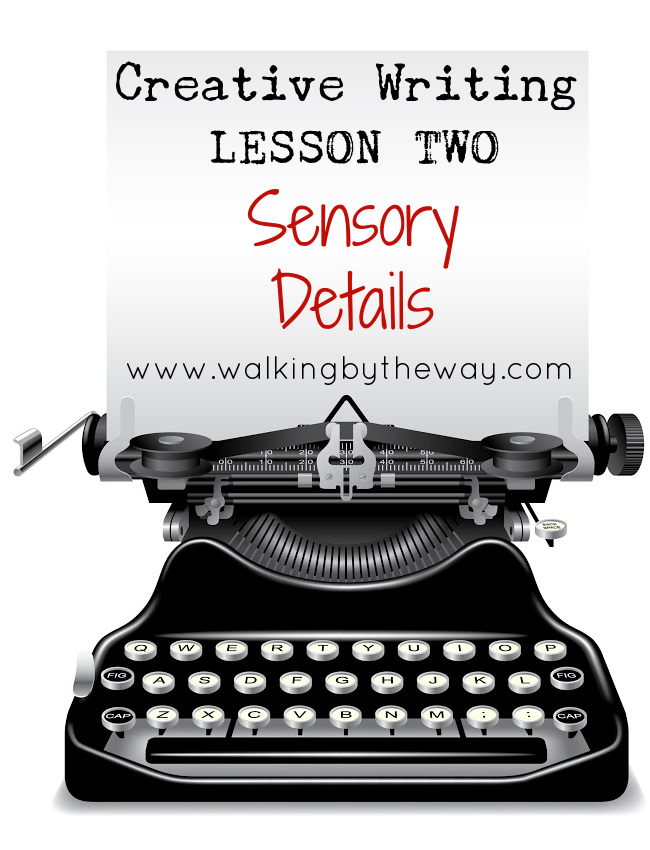
The second creative writing lesson introduces students to writing with sensory details.
We spent the second lesson learning about sensory details and why it’s important to include them in our writing.
Writing with Sensory Details

Sensory details? Who cares?
Writing with sensory details is a topic that is relevant to your students. Sights, sounds, smells–these are the things that transport a reader to a time and place. Sensory details provide readers with an experience.
Creative Writing Lesson Plan: Writing with Sensory Details
1. Students read their metaphor poems (assigned last week).
2. We discussed the five senses and how we use our senses to explore the world. Writers can engage the sense of the reader; it makes the writing real.
3. We read Owl Moon by Jane Yolen and discussed her mastery with sensory details. What are the sights we see (through her words, not the pictures)? What are the sounds we hear? What are the things we feel like we can touch? Smell?
Sensory details make the story work for the readers; Yolen transports us to the snowy woods where we are curious and hopeful.
4. Sensory Details Exercise
I gave each student a cotton ball, a Hershey kiss, and a jingle bell. I also gave each student a sensory detail chart (found in this week’s printable pack.)
Students used the items to complete a sensory detail chart. However, before they started, I banned them from using these common words: sweet, chocolate, candy, jingle, bell, cotton, etc. I did this because I want to stretch their brains–creative thinking is the goal.
I also encouraged the students to use metaphor and simile. You might get some wide eyed stares in this moment. Remind your students that this kind of thinking is hard work. Writing isn’t for wimps!
5. Where Am I? Sensory Details Writing Activity
The point of this activity is to provide students with an experience that will promote writing with sensory details.
You will need blindfolds, a mix of music (about five minutes worth), candy (I use peppermint patties), spray bottles, and fans.
My wonderful assistant and I blindfolded the students. We took them into a another classroom where a sensory adventure awaited.
While blindfolded, students heard music playing–rowdy western music, quiet classical music, and even a thunderstorm.
While the music was playing, we sprayed a light smelling lavender spray in the room.
We misted the students with water (nothing crazy!). Just some “light rain” from water bottles.
Blowing fans gave us a wind effect; we turned the fans up and down and all around.
Students also found a peppermint patty on their desks. At some point during the sensory detail experience, we told students about the candy and instructed them to smell it and taste it, if (if they wanted to).
This sensory detail writing activity should last for about 3-5 minutes. At the end, instruct your students to take off their blindfolds. Give them sensory detail charts and ask them to record as many sensory details as possible.
6. We read over the assignment sheets and asked questions.
One last teaching tidbit:
While reading over the assignments, we discussed the overuse of sensory details. We don’t want to bog the reader with too much to swim through.
I gave my students the example of a pizza. I asked them each what toppings they like. I told them to think of their writing like a pizza. You start with the crust, sauce, and cheese. You want to add some sensory details (toppings), but you don’t want to be too zealous. It would be like trying to eat a pepperoni, green pepper, black olive, mushroom, marshmallow, blueberry, pineapple, jellybean pizza. Or something insane like that. Ew.
Creative Writing Lesson Printables for Writing with Sensory Details
If you’d like a copy of the printables I used for this creative writing lesson, simply click on the image below.
It includes the homework assignments and the sensory details charts.
More Creative Writing Lessons
If you are looking for additional creative writing lessons, try these:


Ami
I absolutely love and appreciate this series that you’re sharing. I love writing, it’s one of my passions, but translating it into lessons for my kids has been a challenge and I’m not satisfied with the curriculum that I’ve seen so far. So we’re making it up as we go along. We’ll definitely be doing this in our home and possibly with our co-op as well. Can’t wait for the rest of the posts…
Awesome! I’m an elementary school teacher and we always had fun coming up with ways to add sensory details. I love the blindfold idea.
One of my favorite lessons for adding details to writing in general was using Dr. Seuss’ And to Think that I Saw It on Mulberry Street. The little boy starts out with a boring story and adds and changes it to make it more interesting. We read the book to the kids and then paired them up to come up with their own story that no one could beat. The results are fantastic!